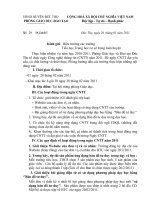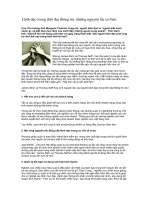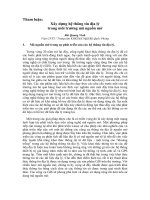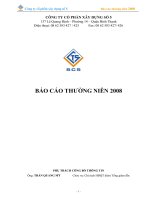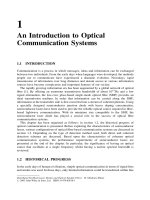Tài liệu Laser điốt được phân phối thông tin phản hồi và các bộ lọc du dương quang P12 docx
Bạn đang xem bản rút gọn của tài liệu. Xem và tải ngay bản đầy đủ của tài liệu tại đây (68.75 KB, 7 trang )
12
Conclusion, Summary and
Suggestions
12.1 SUMMARY AND CONCLUSION
In this book, the performance characteristics of distributed feedback semiconductor laser
diodes and optical tunable filters based on DFB laser structures have been investigated. As
discussed in Chapter 1, these lasers can be used as optical sources and local oscillators in
coherent optical communication networks, in which a stable single mode (in both the
transverse plane and the longitudinal direction) and narrow spectral linewidth become
crucial. Based on the interaction of electromagnetic radiation with a two-energy-band
system, the operating principles of semiconductor lasers were reviewed in Chapter 2. With
partially reflecting mirrors located at the laser facets, a Fabry–Perot laser forms the simplest
type of optical resonator. However, due to the broad gain spectrum, multi-mode oscillations
and mode hopping are common for this type of laser. Nevertheless, single longitudinal mode
operation becomes feasible with the use of DFB LDs. The characteristics of the DFB laser
were explained using the coupled wave equations. With a built-in periodic corrugation,
travelling waves are formed along the direction of propagation in which a perturbed
refractive index and/or gain are introduced. In fact, DFB lasers act as optical bandpass filters,
so that only frequency components near the Bragg frequency are allowed to pass. The
strength of optical feedback is measured by the strength of the coupling coefficient. Based
on the nature of the coupling coefficient, DFB semiconductor lasers can be classified into
purely index-coupled, mixed-coupled and purely gain- or loss-coupled structures.
The discussion focused on the coupled wave equations in Chapter 3. In the analysis,
eigenvalue equations were derived for various structural configurations and consequently,
their threshold currents and lasing wavelengths were determined. From the lasing threshold
characteristics, impacts due to the coupling coefficient, the laser cavity length, the facet
reflectivities, the residue corrugation phases and phase discontinuities were discussed in a
systematic way. With a single /2 phase shift introduced at the centre of the DFB cavity, the
quarterly-wavelength-shifted DFB LD oscillates at the Bragg wavelength. Due to non-
uniform field distribution, however, the single-mode stability of this structure deteriorates
quickly when the biasing current increases. Based on a five-layer separate confinement
heterostructure, the coupling coefficient of a trapezoidal corrugation was computed, from
Distributed Feedback Laser Diodes and Optical Tunable Filters H. Ghafouri–Shiraz
# 2003 John Wiley & Sons, Ltd ISBN: 0-470-85618-1
which coupling coefficients of other corrugation shapes, like triangular and rectangular
gratings, were also evaluated [1].
In Chapter 4, the idea of the transfer matrix was introduced and explored. Compared with
the boundary matching approach in deriving the eigenvalue equation, the transfer matrix
method (TMM) is more robust and flexible. By converting the coupled wave equations into a
matrix formation, the characteristics of a corrugated DFB laser section can be represented by
a2Â 2 matrix. This approach has been extended to include phase discontinuity and the
effect of residue reflection at the facets. By modifying the elements of the transfer matrix,
they can also be used to represent other planar and corrugated structures including passive
waveguides, the distributed Bragg reflector and planar Fabry–Perot sections. Using these
transfer matrices as building blocks, a general N-sectioned laser cavity model was
constructed and the threshold analysis for such a laser model was discussed. With perfectly
matched boundaries between consecutive transfer matrices, the number of boundary
conditions is reduced significantly. Only the boundary condition located at the laser facet
remains to be matched. As compared with the eigenvalue equation, the TMM and/or TLLM
simplifies the threshold analysis dramatically. In a similar way, the transfer matrix has also
been implemented to evaluate the below-threshold spontaneous emission power spectrum
P
N
. By combining the Poynting vector with the method of Green’s function, numerical
results obtained from the three-phase-shift DFB LD were presented and the structural impact
on the spectral behaviour discussed [2].
In revealing the potential use of the TMM and/or TLLM in the practical design of
DFB LDs, the threshold analysis of various DFB laser structures, including the 3PS [3]
and distributed coupling coefficient [4], was carried out in Chapter 5. In an attempt to
minimise the effect of the SHB and hence improve the maximum available single-mode
output power, it is necessary that a stable single longitudinal mode LD shows a high
normalised gain margin ðÁLÞ and a uniform field intensity (i.e. small value of flatness, F).
Based on the lasing performance at threshold, selection criteria were set at ÁL > 0:25 and
F < 0:05 for a 500 mm length laser cavity. Using these optimised structures, complexities
with respect to the design of DFB lasers may be reduced. By changing the value of phase
shifts, the coupling coefficient and their corresponding positions, results such as the gain
margin ðÁLÞ and the uniformity of the field distribution (F) were presented. A
conventional single QWS DFB was selected for comparison purposes. This structure is
characterised by an intense electric field found at the centre of the cavity. With the
introduction of multiple phase shifts along the laser cavity, a 3PS DFB LD with three
p/3 phase shifts and a position factor of 0.5 falls within the selection criteria of ÁL and F.
In an alternative approach, the introduction of the DCC also appears to be promising. An
improvement in the gain margin was shown for a DCC þ QWS DFB laser structure with a
coupling ratio of
1
=
2
¼ 1=3 and a corrugation change at 0.46. Despite the fact that the
flatness of this design does not match the requirements of the selection criteria, a high gain
margin and oscillation at the Bragg wavelength still count as an advantage in the DCC DFB
laser design.
The N-sectioned laser cavity model has been used to determine both the threshold and the
below-threshold performance of DFB LDs. However, the TMM and/or TLLM used has to be
modified when the stimulated emission becomes dominant in the above-threshold biasing
regime. In Chapter 6, a new technique [5] which combines the TMM and/or TLLM with the
carrier rate equation was introduced. In the model, multiple carrier recombination and a
parabolic gain model were assumed. To include any gain saturation effects, a non-linear gain
coefficient was introduced. The algorithm needs no first-order derivative and has been
304
CONCLUSION, SUMMARY AND SUGGESTIONS
developed in such a way that, with minor modification, the same algorithm can be applied
to various laser structures. The TMM-based above-threshold laser model was applied to
several DFB laser structures including the QWS, 3PS and the DCC DFB LDs. The QWS
DFB laser structure, which is characterised by its non-uniform field distribution, was shown
to have a large dynamic range of spatially distributed refractive index. Along the carrier
concentration profile, a dip was shown at the centre of the cavity where the largest
stimulated photon density was found. By introducing more phase shifts along the
corrugation, results from a 3PS DFB LD with
2
¼
3
¼
4
¼ p=3 and PSP ¼ 0:5 were
presented. Uniform distributions were observed in the carrier density, photon density
and the refractive index profile. With an improved threshold gain margin, the above-
threshold characteristics of a QWS LD having non-uniform coupling coefficient were also
shown. As compared with the QWS structure, the introduction of a non-uniform coupling
coefficient with
1
=
2
¼ 1=3 and CP ¼ 0:46 increased the localised carrier concentration
near the plane of corrugation change. A significant reduction in the photon density
difference between the central peak and the emitting photon density near the facet was also
found.
Based on the TMM and/or TLLM, the above-threshold model was extended and applied
to evaluate spectral and noise properties of DFB LDs in Chapter 7. Based on the lasing mode
distributions obtained for the carrier density, photon density, refractive index and the field
intensity, characteristics like the single-mode stability, the spontaneous emission spectrum
and the spectral linewidth were investigated. At a fixed biasing current, the QWS structure
having the smallest threshold gain was shown to have the smallest linewidth. On the other
hand, the non-lasing þ1 side mode became stronger with increasing bias current.
Comparatively, the 3PS structure was shown to have the smallest change in lasing
wavelength. With the introduction of multiple phase shifts along the corrugation, the internal
field distribution becomes more uniform and hence a stable single-mode oscillation results.
It is shown that the DCC þ QWS structure has the largest gain margin. The introduction of a
distributed coupling coefficient improved the single-mode stability in such a way that the
side mode suppression ratio remained at a high value. Wavelength tunability is also
improved in this structure. From these results, it is apparent that the design of the DFB LD
depends much on its applications. On the other hand, the TMM and/or TLLM has proved to
be a powerful tool when dealing with such a problem.
In Chapter 8 the transmission line laser model was discussed. TLLM can be classified as a
distributed-element circuit model, which is based on the 1-D transmission line matrix
method. The building blocks of a TLM network are the TLM link lines and stub lines. It has
been shown how the scattering matrices of several TLM sub-networks may be derived by
using Thevenin-equivalent circuits. Scattering and connecting are the two main processes
that form the basis of TLM. The scattering matrix at a TLM node takes incident voltage
pulses and operates on them to produce reflected pulses that travel away from the node. The
connecting matrix then directs the reflected pulses from one TLM node to adjacent TLM
nodes, where they become incident pulses of the adjacent nodes in the next time iteration. In
TLLM, the voltage pulses represent the optical waves that circulate inside the laser cavity.
All the important optical processes in the laser are taken into account, such as the spectrally-
dependent gain of stimulated emission, material and scattering loss, spontaneous emission,
carrier–photon interaction and carrier-dependent phase shift. The microwave circuit
elements of TLLM are used to describe these laser processes on an equivalence basis.
The baseband transformation method is used to enhance the computational efficiency by
down-converting from the true optical carrier frequency to its equivalent baseband value.
SUMMARY AND CONCLUSION
305
The TLLM is a stochastic laser model because random noise effects are included, making it
a highly realistic model compared to deterministic laser models. However, intensive time
averaging and smoothing techniques are required to obtain the wanted signal, which may
otherwise be masked by noise.
In Chapter 9 TLLM was modified to allow study of dynamic behaviour of distributed
feedback laser diodes, in particular the effects of multiple phase shifts on the overall DFB
LD performance. We can easily model any arbitrary phase shift value by inserting some
phase shifter stubs into the scattering matrices of TLLM. This helps to make the electric field
distribution and hence light intensity of DFB LDs more uniform along the laser cavity and
hence minimise the hole burning effect.
In Chapter 10 optical tunable filters were introduced. An active optical tunable filter with
frequency characteristics that can be tailored to a desired response is an enabling technology
for exploiting the full potential bandwidth of optical fibre communication systems. Having
seen the importance of such active optical tunable filters, it is highly desirable to design a
tunable filter which can perform filtering and amplification of the filtered signal
simultaneously. In this chapter, active grating-embedded filters were analysed and designed
based on the TMM outlined, where the coupled wave equations of the DFB LD amplifier
filters were solved. In addition, the dispersion relationship and the stop band were
also discussed. From the solutions of the eigenvalue equations, which were derived by
matching the boundary conditions, the threshold current and the lasing wavelength were
determined. These included the analysis of the phase discontinuities and the below-threshold
characteristics of DFB LDs. The principle of the active tunability of DFB LD amplifier
filters was discussed and the structural impacts of the performance of the filters were
justified.
The effects of grating period and coupling coefficient on the performance characteristics
of a novel multi-section and phase-shift-controlled DFB wavelength tunable optical filter
have also been studied. It was found that this filter structure offers a wide tuning range with
narrow bandwidth, high gain and large SMSR. The filter has over 30 dB peak gain within the
tuning range, which is 32.0 A
˚
for ¼ 6mm
À1
and 42 A
˚
for ¼ 10 mm
À1
. The filter SMSR
varies between 12 dB and 30.2 dB. Finally, some analyses on the three-section DBR LD
amplifier filter were carried out. It was found that this structure is not suitable for a multi-
section design since mode hopping occurs in the main lobe, though the tuning range can be
increased. Besides, it is very difficult to monolithically integrate the sections without error in
practice, since the reflectivities of each section will contribute to the threshold amplitude.
Furthermore, the Bragg reflector is lossy and thus a higher threshold current will be
required.
The effects of grating period and coupling coefficient on the performance characteristics
of a =4-phase-shifted double-phase-shift-controlled DFB wavelength tunable optical filter
were studied in Chapter 11. It was found that the new laser-based filter structure offers a
wide tuning range with narrow bandwidth, high gain and large SMSR. The filter has over
30 dB peak gain within its tuning range, which is 28.3 A
˚
for ¼ 6mm
À1
and 34.3 A
˚
for
¼ 10 mm
À1
. The filter SMSR varies between 15 and 34.7 dB. Also, we investigated
the effects of phase shifts
1
and
4
on tuning range, peak transmissivity and SMSR of single
PSC DFB filters. It was found that when
1
< p=2 and
4
> p=2, the filter tuning range
increases. Also, peak transmissivity of more than 35 dB and SMSR of better than 15 dB can
be achieved. The analytical investigation showed that the three-phase-shift-controlled DFB
wavelength tunable optical filter has a wide tuning range with narrow bandwidth and
high gain (see Figs 11.15 to 11.18). However, these two additional waveguide sections
306
CONCLUSION, SUMMARY AND SUGGESTIONS
contribute to a larger amount of free carrier absorption which alters the threshold gain
slightly. The calculations are based on the assumption that the relationships of the grating
phases at the two sides of the wavelength region are the same for the two O
2
phase-control
regions.
12.2 THE TMM AND/OR TLLM ANALYSIS
In the analysis, the most important characteristics, namely the single-mode stability, spectral
linewidth and the spectral behaviour of DFB LDs, have been investigated using the QWS,
3PS and DCC laser structures. The TMM and/or TLLM has provided the flexibility one
needs in the design of DFB LDs. There are other dynamic characteristics such as AM and
FM response [6–9] and the use of multiple electrode configuration [10–11] which are also
important in the characterisation of laser devices.
12.3 FUTURE RESEARCH
Based on the TMM and/or TLLM, the characteristics of DFB LDs have been investigated.
Detailed analysis covering both below- and above-threshold biasing regimes has been
presented. There are at least three possible research directions which may be worth further
investigation.
12.3.1 Extension to the Analysis of Quantum Well Devices
In this book, we have concentrated on bulk devices only. There is a potential to apply the
same TMM and/or TLLM technique to quantum well structures [12]. The major differences
between QW lasers and bulk ones, which we have been examining, are the recombination
mechanism [13], material gain characteristics, band structure [14] and confinement factor
[15]. One can replace some of the equations used in the bulk model with those appropriate
for QW structures. The analysis and the algorithm will remain the same as for the bulk
devices described earlier.
12.3.2 Extension to Gain-coupled Devices
DFB LDs used in this book belong to the group of purely index-coupled devices. The
wavelength filtering mechanism is solely caused by the perturbation of refractive index. In
recent years, there has been a growing interest in the use of mixed-coupled and purely gain-
coupled devices [16–20]. With the coupling coefficient depending on the material gain, it
has been shown both in theory [21] and experiment [22] that these devices exhibit stable
single-mode oscillation at the Bragg wavelength. Even for a small degree of gain coupling, a
mixed-coupled device shows an improvement in the gain margin. By introducing an
imaginary term into the coupling coefficient used in the model, the characteristics of these
devices can be investigated using the same methodology.
FUTURE RESEARCH
307
